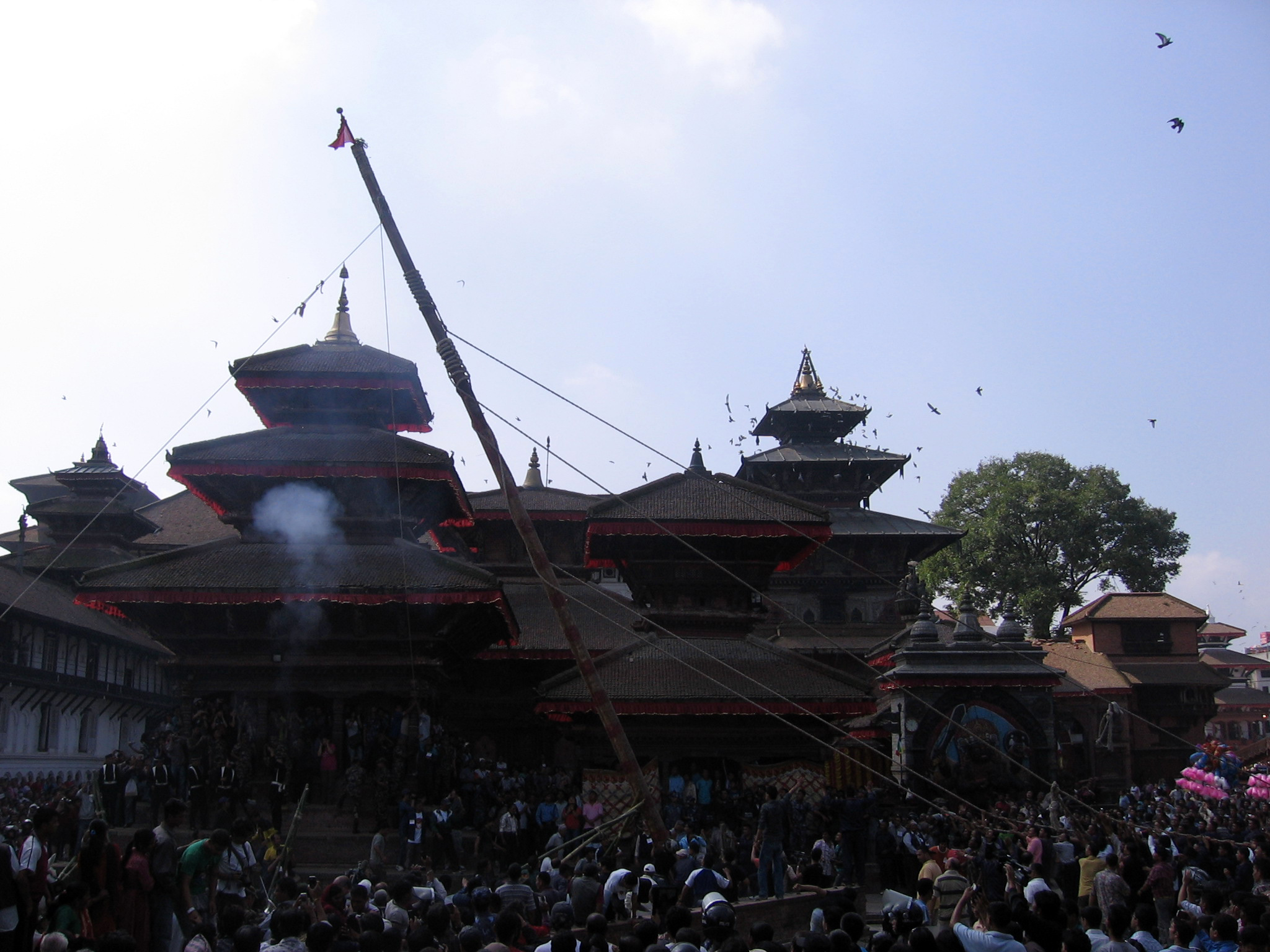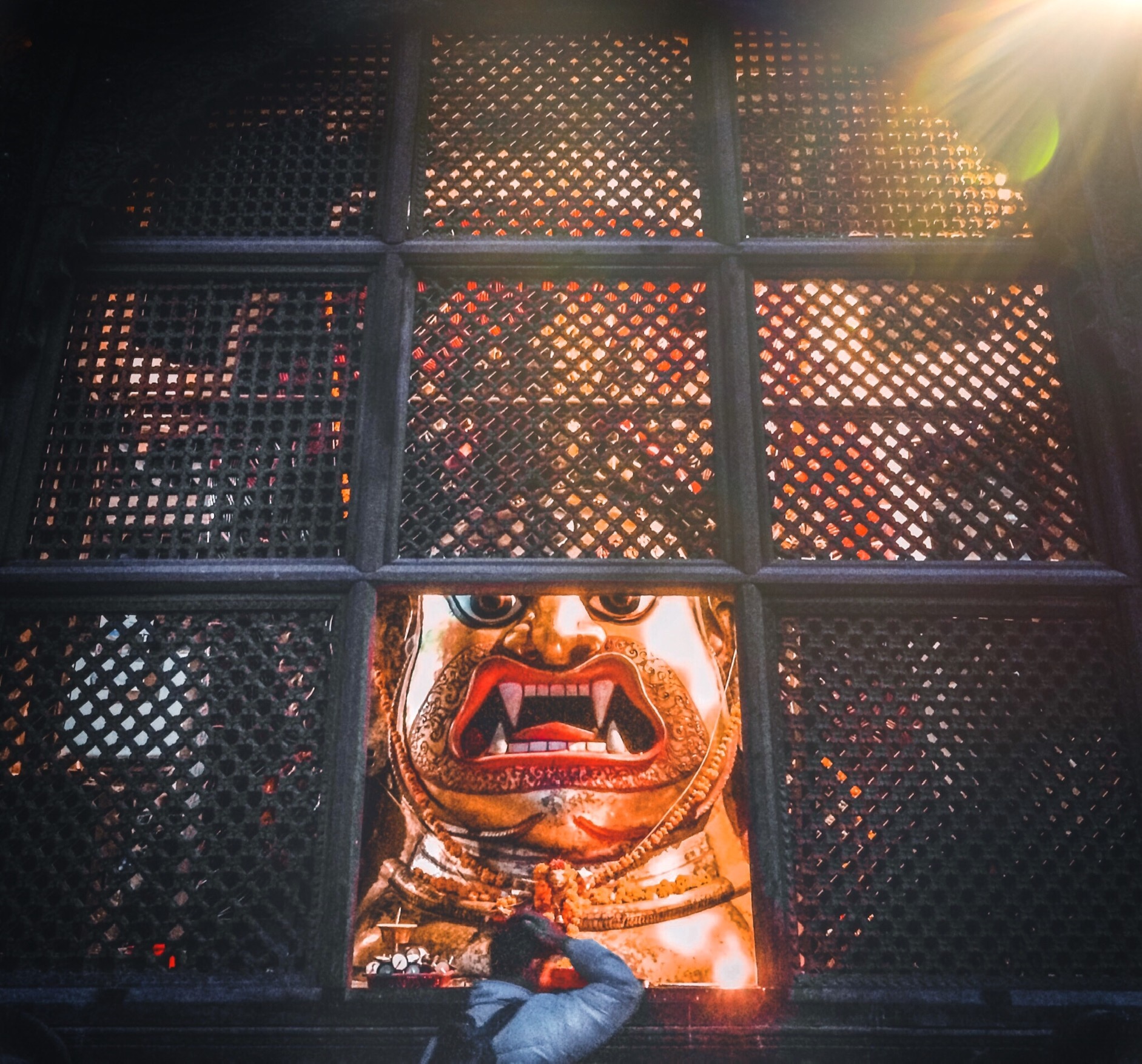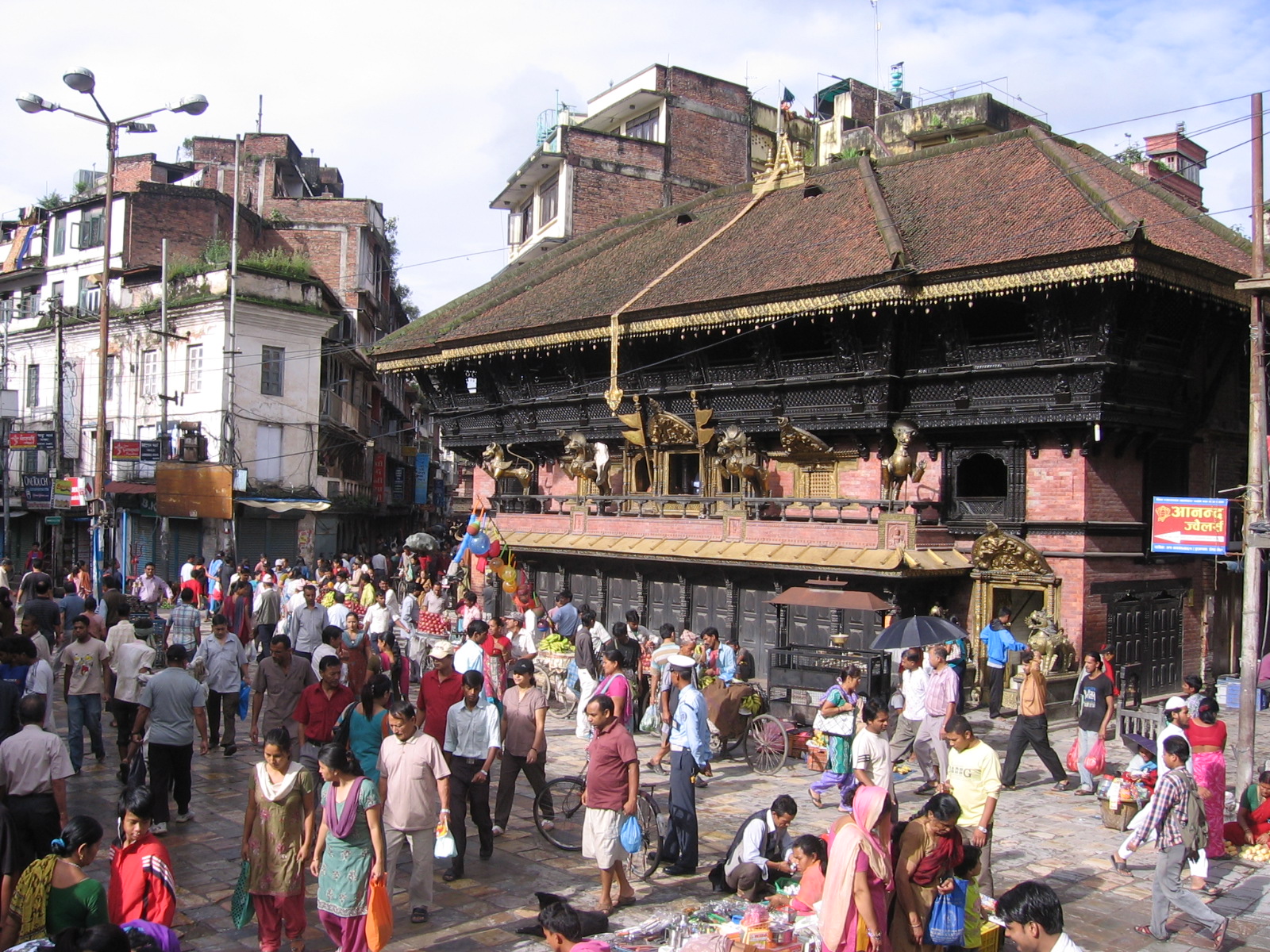|
Indra Jatra
Indra Jātrā, also known as Yenyā (Nepal Bhasa: येँयाः), is the biggest religious street festival in Kathmandu, Nepal. The celebrations consist of two events, Indra Jātrā and Kumāri Jātrā. Indra Jātrā is marked by masked dances of deities and demons, displays of sacred images and tableaus in honor of the deity Indra, the king of heaven. Kumāri Jātrā is the chariot procession of the living goddess Kumari. Family members deceased in the past year are also remembered during the festival. The main venue of the festivities is Kathmandu Durbar Square. The celebrations last for eight days from the 12th day of the bright fortnight to the 4th day of the dark fortnight of Yanlā (ञला), the eleventh month in the lunar Nepal Era calendar. Indra Jatra was started by King Gunakamadeva- (गुणकामदेव) to commemorate the founding of the Kathmandu city in the 10th century. Kumari Jatra began in the mid-18th century. The celebrations are held accord ... [...More Info...] [...Related Items...] OR: [Wikipedia] [Google] [Baidu] |
Sweta Bhairava
Swet Bhairav is a statue of Bhairava, avatar of Shiva located in Hanuman Dhoka, Kathmandu Durbar Square. Swet Bhairav depicts the most dangerous and fierce face of Lord Shiva. The mask of Swet Bhairab is so fierce looking that locals out of fear keep it inside a wooden frame window, and only one frame is opened for the devotees except for a special day: Indra Jatra when all the windows are opened. In the very day of Indra Jatra Indra Jātrā, also known as Yenyā (Nepal Bhasa: येँयाः), is the biggest religious street festival in Kathmandu, Nepal. The celebrations consist of two events, Indra Jātrā and Kumāri Jātrā. Indra Jātrā is marked by masked danc ... a wooden/ bamboo straw is placed in the mouth of the statue and rice liquor is siphoned as a ''prasad'' for the devotees. The alcohol if consumed is believed to bring good health and fortune via the blessings of Swet Bhairav. Inside the wooden latticed screen, below Dega Taleju is hidden the terrifying face ... [...More Info...] [...Related Items...] OR: [Wikipedia] [Google] [Baidu] |
Jaya Prakash Malla
Jaya Prakash Malla ( ne, जयप्रकाश मल्ल) (died 1768) was the last king of Yen (यें) or Kantipur (कान्तिपुर) which corresponds to present-day Kathmandu. He ruled from 1736 to 1746, and then from 1750 until his death in 1769. He spent most of his reign in constant conflict with other Nepali kingdoms including that of Prithvi Narayan Shah in the Battle of Kathmandu. He was the last king of Kathmandu (at that time, Kathmandu functioned as an independent state or principality) before King Prithvi Narayan Shah attacked Kathmandu when the Kathmandu city folk were celebrating the festival of Indrajatra and conquered it. He contributed to the literature of Nepal Bhasa with works such as "Padma Samuchaya" and three dramas that were concerned with Hindu mythology being ''Ratneshwar Pradurbhav'', ''Birdhwojopakhyan Natakam'' and ''Bhairavpradurbhav''. When Gorkhali king Prithvi Narayan Shah attacked Nuwakot, a protectorate of Kantipur, Jaya P ... [...More Info...] [...Related Items...] OR: [Wikipedia] [Google] [Baidu] |
Dasavatar
The Dashavatara ( sa, दशावतार, ) are the ten primary avatars of Vishnu, a principal Hindu god. Vishnu is said to descend in the form of an avatar to restore cosmic order. The word ''Dashavatara'' derives from , meaning "ten", and , roughly equivalent to "incarnation". The list of included avatars varies across sects and regions, particularly in respect to the inclusion of Balarama (brother of Krishna) or Gautama Buddha. Though no list can be uncontroversially presented as standard, the "most accepted list found in Puranas and other texts is ..Krishna, Buddha." Most draw from the following set of figures, in this order: Matsya; Kurma; Varaha; Narasimha; Vamana; Parashurama; Rama; Krishna or Balarama; Buddha or Krishna; and Kalki. In traditions that omit Krishna, he often replaces Vishnu as the source of all avatars. Some traditions include a regional deity such as Vithoba or Jagannath in penultimate position, replacing Krishna or Buddha. All avatars have appeared ... [...More Info...] [...Related Items...] OR: [Wikipedia] [Google] [Baidu] |
Yalambar
Yalamber or Yalung, Yalambar, Yalamwar, Yalamver ( Nepali: यलम्बर) was a Kirat warrior and first King of Kirata Kingdom in Nepal. He established Kirata Kingdom in 800 B.C.Kirat Yoyakhha His capital was Yalakhom, present day Kathmandu Valley ( Thankot) after conquering Central Nepal and his kingdom extended from river Trishuli in the west to river Teesta in the east of Bhutan. Patan also known as (Lalitpur in Nepali and Yala in Nepal Bhasa) is resemblance to Yalamber as he ruled the regions. Brian Houghton Hodgson - Wikipedia elaborated more on the origins. The epic Mahabharata mentions the ''Kiratas'' as a Mleccha tribe along with Pulindas and Chinas, Hunas, Pahlavas, Sakas, Yavanas, Savaras, Paundras, Kanchis, Dravidas, Sinhalas and Keralas. All these tribes were described as Mlechha tribes. The Kamvojas, Gandharas, Kiratas and Barbaras were also mentioned together as northern tribes. The Yavanas, the Kiratas, the Gandharvas, the Chinas, the Savara ... [...More Info...] [...Related Items...] OR: [Wikipedia] [Google] [Baidu] |
Mahabharata
The ''Mahābhārata'' ( ; sa, महाभारतम्, ', ) is one of the two major Sanskrit literature, Sanskrit Indian epic poetry, epics of ancient India in Hinduism, the other being the ''Ramayana, Rāmāyaṇa''. It narrates the struggle between two groups of cousins in the Kurukshetra War and the fates of the Kaurava and the Pandava, Pāṇḍava princes and their successors. It also contains Hindu philosophy, philosophical and devotional material, such as a discussion of the four "goals of life" or ''purusharthas, puruṣārtha'' (12.161). Among the principal works and stories in the ''Mahābhārata'' are the ''Bhagavad Gita'', the story of Damayanti, the story of Shakuntala, the story of Pururava and Urvashi, the story of Savitri and Satyavan, the story of Kacha (sage), Kacha and Devayani, the story of Rishyasringa and an abbreviated version of the ''Ramayana, Rāmāyaṇa'', often considered as works in their own right. Traditionally, the authorship of the ''M ... [...More Info...] [...Related Items...] OR: [Wikipedia] [Google] [Baidu] |
Shiva
Shiva (; sa, शिव, lit=The Auspicious One, Śiva ), also known as Mahadeva (; ɐɦaːd̪eːʋɐ, or Hara, is one of the principal deities of Hinduism. He is the Supreme Being in Shaivism, one of the major traditions within Hinduism. Shiva is known as "The Destroyer" within the Trimurti, the Hindu trinity which also includes Brahma and Vishnu. In the Shaivite tradition, Shiva is the Supreme Lord who creates, protects and transforms the universe. In the goddess-oriented Shakta tradition, the Supreme Goddess (Devi) is regarded as the energy and creative power (Shakti) and the equal complementary partner of Shiva. Shiva is one of the five equivalent deities in Panchayatana puja of the Smarta tradition of Hinduism. Shiva has many aspects, benevolent as well as fearsome. In benevolent aspects, he is depicted as an omniscient Yogi who lives an ascetic life on Mount Kailash as well as a householder with his wife Parvati and his three children, Ganesha, Kartikeya and ... [...More Info...] [...Related Items...] OR: [Wikipedia] [Google] [Baidu] |
Baka Bhairav Kathmandu
Baka, baká or BAKA may refer to: Ethnicities and languages * Baka people (Cameroon and Gabon), an African ethnic group * Baka people (Congo and South Sudan), an African ethnic group * Baka language, a dialect cluster of Cameroon and Gabon * Baka language (South Sudan), a Central Sudanic language of South Sudan People with the name * Józef Baka, 18th century poet, Jesuit priest and missionary * Latifa Baka (born 1964), Moroccan author * Bikheris or Ba-Ka, Fourth Dynasty Egyptian pharaoh * Baka (prince), Fourth Dynasty Egyptian prince who might be the above-named Bikheris * Baka Prase (born 1996), Serbian YouTuber, rapper, gamer and entertainer Fictional and mythical characters * Bakasura, a mythical demon in the ''Mahabharata'' also known as Baka * Baka Brahma, a deity in Buddhism - see Brahmā (Buddhism) * Bākā, a character from ''Juken Sentai Gekiranger'' * Cirno, a fictional character from the ''Touhou Project'' who is often referred to by its fans and creator as "baka" ... [...More Info...] [...Related Items...] OR: [Wikipedia] [Google] [Baidu] |
Kasthamandap
Kasthamandap (Sanskrit: काष्ठमण्डप, Nepal Bhasa:मरु सत: ''Maru Satta:''; literally "Wood-Covered Shelter") was a three-storied public shelter that included a shrine consecrated to Gorakshanath situated at Maru, Kathmandu, Nepal. Several myths and stories about the date of the construction of the Kasthamandap have been resolved with the recent archeological findings: newly discovered objects during the excavation in the aftermath of the 2015 earthquake have suggested that the Kasthamandap may have been built in the 7th century during the Lichhavi era. 2015 Nepal earthquake and subsequent excavations A team of international and national experts from the Department of Archaeology (DoA), Government of Nepal and Durham University had excavated beneath the Kasthamandap and found coal and sand in the foundations. The foundation soil, coal, and sand were taken to the University of Stirling, Scotland for carbon and optically stimulated luminescence (OSL ... [...More Info...] [...Related Items...] OR: [Wikipedia] [Google] [Baidu] |
Newar
Newar (; new, नेवार, endonym: Newa; new, नेवा, Pracalit script:) or Nepami, are the historical inhabitants of the Kathmandu Valley and its surrounding areas in Nepal and the creators of its historic heritage and civilisation. Page 15. Newars form a linguistic and cultural community of primarily Indo-Aryan and Tibeto-Burman ethnicities following Hinduism and Buddhism with Nepal Bhasa as their common language. Newars have developed a division of labour and a sophisticated urban civilisation not seen elsewhere in the Himalayan foothills. Newars have continued their age-old traditions and practices and pride themselves as the true custodians of the religion, culture and civilisation of Nepal. Newars are known for their contributions to culture, art and literature, trade, agriculture and cuisine. Today, they consistently rank as the most economically and socially advanced community of Nepal, according to the annual Human Development Index published by UND ... [...More Info...] [...Related Items...] OR: [Wikipedia] [Google] [Baidu] |
Indra Chok, Kathmandu
Indra Chowk ( ne, इन्द्रचोक) or Wongha: is one of the ceremonial and market squares on the artery passing through the historic section of Kathmandu, Nepal. The intersection of Indra Chowk, along with Maru, Kathmandu Durbar Square, Makhan, Jana Baha, Asan and Naxal, mark the old India-Tibet trade route that is now a vibrant market street. Six streets meet at Indra Chowk and link the square to Kathmandu's major localities. Its temples and bazaar draw streams of pilgrims and shoppers. The square is named after Indra, lord of heaven in Hindu mythology. Indra Chowk is a ceremonial venue and major festival pageants and chariot processions pass through the square. During Indra Jatra, the chariots of Kumari, Ganesh and Bhairav are pulled through here. The chariot procession of Jana Baha Dyah Jatra also passes through the square. Highlights * The large temple of Akash Bhairav (alternative name: Āju Dyah आजुद्यः) on the western side of the square is th ... [...More Info...] [...Related Items...] OR: [Wikipedia] [Google] [Baidu] |
Asan, Kathmandu
Asan ( new, असं, ne, असन) (alternative names: Asan Tol असन टोल, Asan Twāh असं त्वाः) is a ceremonial, market and residential square in central Kathmandu, the capital of Nepal. It is one of the most well-known historical locations in the city and is famed for its bazaar, festival calendar and strategic location. Asan has been described as one of the fine Newar examples of a traditional Asian bazaar. The Tuladhar, Maharjan, Shrestha, Bajracharya and Shakya castes make up most of the population. Six streets converge on Asan giving the square a perpetual bustle. The bazaar at Asan attracts shoppers from all over Kathmandu because of the tremendous variety of merchandise sold here, ranging from foodstuffs, spices and textiles to electronics and bullion. Asan is also one of the popular tourist spots fokathmandu walking tourin the city because of its architectural sights and charming ambiance. There are banks, restaurants and a post office ... [...More Info...] [...Related Items...] OR: [Wikipedia] [Google] [Baidu] |








